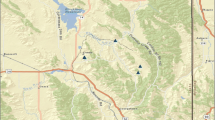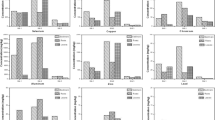Summary
One of the major concerns in central California (San Joaquin Valley) is the level of selenium (Se) in evaporation ponds containing agricultural drainage water. The objective of this work was to determine if volatilization of Se could be used as a bioremediation program to detoxify a saline seleniferous sediment of a dewatered evaporation pond. The dewatered sediment was rototilled, divided into subplots, and amended with various organic materials including citrus (orange) peel, cattle manure, barley straw and grape pomance. Some of the subplots were fertilized with nitrogen [(NH4)2SO4] and zinc (ZnSO4). Selenium volatilization was monitored in the field with a flux chamber system utilizing alkaline peroxide to trap the gas. Overall, the greatest emission of gaseous Se was recorded in the summer months and the lowest emission during the winter months. The background emission of volatile Se averaged 3.0 μg Se h−1 m−2. The most effective organic amendment was cattle manure with an avg. Se emission of 54 μg Se h−1 m−2. Composite soil samples from each subplot (upper 15 cm) were analyzed for total Se on a monthly interval during the course of this field study. After 22 months, the application of water plus tillage alone removed 32.2% of the Se content while the cattle manure treatment removed 57.8%. Among the parameters which enhanced volatilization of Se were an available C source, aeration, moisture, and high temperatures. This field study indicates promising results in detoxifying seleniferous sediments via microbial volatilization once environmental conditions have been optimized.
Similar content being viewed by others
References
Abu-Erreish, G.M., E.I. Whitehead and O.E. Olsen. 1968. Evolution of volatile selenium from soils. Soil Sci. 106: 415–420.
Atkinson, R., S.M. Aschmann, D. Hasegawa, E.T. Thompson-Eagle and W.T. Frankenberger, Jr. 1990. Kinetics of the atmospherically-important reactions of dimethylselenide. Environ. Sci. Tech. 24: 1326–1332.
Barkes, L and R.W. Fleming. 1974. Production of dimethylselenide gas from inorganic selenium by eleven fungi. Bulletin Environ. Cont. Toxicol. 12: 308–311.
Calderone, S.J., W.T. Frankenberger, Jr, D.R. Parker and U. Karlson. 1990. Influence of temperature and organic amendments on the mobilization of selenium in soils. Soil Biol. Biochem. 22: 615–620.
Challenger, F. 1935. The biological methylation of compounds of arsenic and selenium. Chem. Indus. 657–662.
Challenger, F. and H.E. North. 1934. The production of organometalloidal compounds by microorganisms. Part II. Dimethylselenide. J. Chem. Soc. 68–71.
Craig, P.J. 1986. Occurrence and pathways of organometallic compounds in the environment: general considerations. In: Organometallic Compounds in the Environment (Craig, P.J., ed.), pp. 1–64, Longman, Harlow, UK.
Doran, J.W. 1982. Microorganisms and the biological cycling of selenium. Adv. Microbiol. Ecol. 6: 1–31.
EPA Methods for the Chemical Analysis of Water and Wastewater. 1986. Selenium, Method 270.3 (Atomic Absorption, Gaseous Hydride). EPA 600/4-79-020.
Farrell, D.A., E.L. Greacen and C.G. Curr. 1966. Vapor transfer in soil due to air turbulence. Soil Sci. 102: 305–313.
Frankenberger, W.T., Jr and U. Karlson. 1991. Bioremediation of seleniferous soils. In: On-site Bioreclamation (Hinchee, R.E. and R.F. Olfenbuttle, eds), pp. 239–254, Butterworth-Heinemann, Stoneham, MA.
Frankenberger, W.T., Jr and U. Karlson. 1989. Environmental factors affecting microbial production of dimethylselenide in a selenium-contaminated sediment. Soil Sci. Soc. Am. J. 53: 1435–1442.
Karlson, U. and W.T. Frankenberger, Jr. 1993. Biological alkylation of selenium and tellurium. In: Metal Ions in Biological Systems (Sigel, H. and A. Sigel, eds), pp. 185–227, Marcel Dekker, New York.
Karlson, U. and W.T. Frankenberger, Jr. 1990. Volatilization of selenium from agricultural evaporation pond sediments. Sci. Total Environ. 92: 41–54.
Karlson, U. and W.T. Frankenberger, Jr. 1989. Accelerated rates of selenium volatilization from California soils. Soil Sci. Soc. Am. J. 53: 749–753.
Karlson, U. and W.T. Frankenberger, Jr. 1988b. Effects of carbon and trace element addition on alkylselenide production by soil. Soil Sci. Soc. Am. J. 52: 1640–1644.
Karlson, U., W.T. Frankenberger, Jr and W.F. Spencer. 1984. Physicochemical properties of dimethylselenide and dimethyldiselenide. J. Chem. Engineer Data 39: 608–610.
MacKenzie, F.T., R.J. Lantzy and V. Paterson. 1979. Global trace metal cycles and predictions. Mathematical Geol. 11: 99–141.
McConnell, K.P. and O.W. Portman. 1952. Toxicity of dimethylselenide in the rat and mouse. Proc. Soc. Exp. Biol. Med. 79: 230–231.
Ross, H.B. 1985. An atmospheric selenium budget for the region 30°N to 90°N. Tellus 37B: 78–90.
Thompson-Eagle, E.T. and W.T. Frankenberger, Jr. 1992. Bioremediation of soils contaminated with selenium. Adv. Soil. Sci. 17: 261–310.
Thompson-Eagle, E.T. and W.T. Frankenberger, Jr. 1991. Selenium biomethylation in an alkaline, saline environment. Wat. Res. 25: 231–240.
Thompson-Eagle, E.T. and W.T. Frankenberger, Jr. 1990. Proteinmediated selenium biomethylation in evaporation pond water. Environ. Tox. Chem. 9: 1453–1462.
Thompson-Eagle, E.T., W.T. Frankenberger, Jr and U. Karlson. 1989. Volatilization of selenium byAlternaria alternata. Appl. Environ. Microbiol. 55: 1406–1413.
Thompson-Eagle, E.T., W.T. Frankenberger, Jr and K.E. Longley. 1991. Removal of selenium from agricultural drainage water through soil transformations. In: The Economics and Management of Water and Drainage in Agriculture (Dinar, A. and D. Zilberman, eds), pp. 169–186, Kluwer Academic Publishers, Norwell, MA.
Wilber, C.G. 1980. Toxicology of selenium: a review. Clin. Toxicol. 17: 171–230.
Author information
Authors and Affiliations
Rights and permissions
About this article
Cite this article
Frankenberger, W.T., Karlson, U. Volatilization of selenium from a dewatered seleniferous sediment: A field study. Journal of Industrial Microbiology 14, 226–232 (1995). https://doi.org/10.1007/BF01569932
Received:
Accepted:
Issue Date:
DOI: https://doi.org/10.1007/BF01569932




